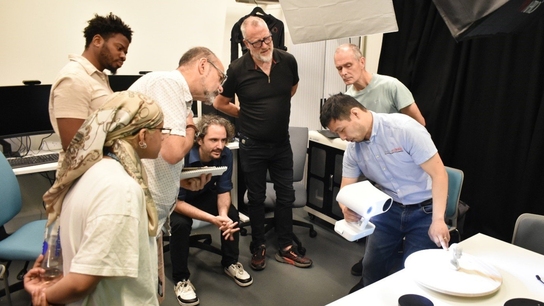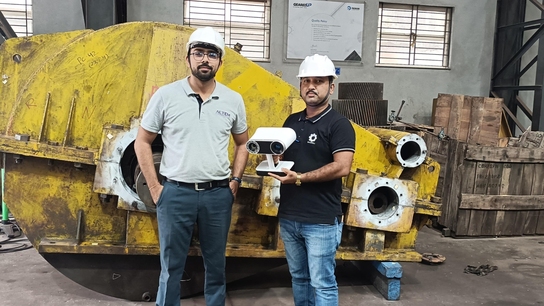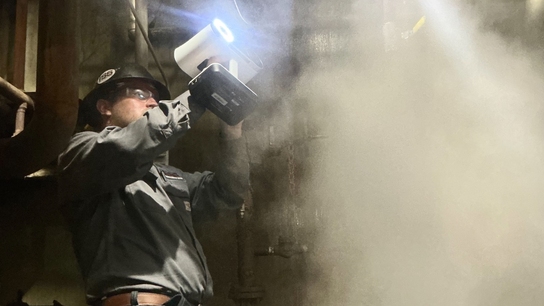How Dr. Sheryl Lewin uses Artec Space Spider to create beautiful new ears for microtia patients
Challenge: A California plastic surgeon dedicated to helping children born with microtia was searching for a gentler and faster way to make the most life-like, long-lasting ears for her patients.
Solution: Artec Space Spider, Artec Studio
Results: In less than a minute, the patient’s “normal-sized” ear is 3D scanned with Artec Space Spider, and from this, an ultra-realistic high-density porous polyethylene implant for the smaller, malformed ear is created. In just one or two surgeries, the patient has a new “big” ear that will last a lifetime.

When Dr. Sheryl Lewin began her career as a craniofacial surgeon, the “gold standard” of surgery for microtia, a condition where a child is born with a malformed or missing ear, was the same as it had been for nearly fifty years.
Rib cartilage ear reconstruction is a complicated procedure that demands anywhere from two to four surgeries, during which a chunk of rib cartilage is cut out of the patient’s chest and then carved into the shape of a healthy ear.
Following this, the cartilaginous ear is surgically slid under the incised skin of the cranium and stitched in place. With surgeries normally taking place at 3-6 month intervals, the path to getting a new ear can take more than a year.
After surgery, these rib cartilage ears often do not appear natural; the rib cartilage ear is much thicker than a normal ear and often lies flat against the head compared to the normal-sized ear. Some doctors then will surgically “pin back” the healthy ear to achieve symmetry.
The majority of microtia surgery patients are children. After enduring the multiple painful surgeries, they will be left with permanent chest scarring, and possibly chest asymmetry from the loss of cartilage.
Younger children often have to wait for the rib cartilage procedure until they are 8-10 years old since their cartilage hasn’t grown large enough to create an adult-sized ear. Until then, they have to suffer with this birth defect, experiencing years of unpleasant stares, comments, and even ridicule from others.
Dr. Lewin was not satisfied with the results and specifically, the accompanying pain and age requirements of the technique. Consequently, she immediately began her quest to develop other surgical options.
This search ultimately led Dr. Lewin to use a synthetic material as an alternative ear framework. Soldering together a two-piece implant made of porous polyethylene offered many advantages for ear reconstruction, including the ability to start as young as 4 years old, a less painful outpatient surgery, and an improved outcome for the appearance of the ear in just 1 or 2 surgeries.
However, since this technique involved joining two pieces, there was a real risk over the patient’s lifetime that the implant could fracture, requiring further surgery to replace the broken implant.
In order to minimize the fracture risk, Dr. Lewin began designing and sculpting one-piece ear implants out of high-density porous polyethylene. In her words, “This material is the best option I know of for creating ear implants. It is the best implant material that I’m aware of because it is the least reactive in the body, unlike the silicone used for breast implants or titanium hip implants.”

A collection of 3D-scanned, Poriferous-created “Lewin ears”
Dr. Lewin continued, “The body sees those materials as foreign and builds a capsule around them to isolate them. But with porous polyethylene, this amazing material encourages tissue integration, with its thousands of pores that are about 100 microns in size.”
“The body’s blood vessels and tissues actually grow into these little holes. To give you an idea of how big each pore is, it’s about as thick as a sheet of paper. This material is proven to be medically safe and made to last a lifetime.”
Dr. Lewin also began redesigning the base of the ear implant, so that once the new ear is in place, it’s symmetrical with the patient’s normal-sized ear. With her “Lewin Ear” design and workflow in place, word among families of patients quickly spread, and soon new patients were coming to her from across the country and from around the world.

Before and after surgery photos of a patient whose life has been transformed
“Creating lifelike ears by hand is a challenging yet incredibly gratifying task. Unfortunately, it also takes a long time. It had taken me more than a decade to reach the level of exactitude that I was happy with, but I still felt the results weren’t perfectly symmetric. I kept looking for that special something, even though I wasn’t sure exactly what it would be,” said Dr. Lewin.
It was one day when she was searching for solutions online that she came across several articles on 3D scanning for healthcare. One thing led to another, and Dr. Lewin found Artec 3D’s website. There she read a fascinating case study about a hospital in the UK that was using the handheld color 3D scanner Artec Spider in their work with microtia patients.
Feeling inspired, Dr. Lewin quickly found the name of her local reseller, Artec Ambassador Rapid Scan 3D, and arranged to have an onsite demo of the scanner. When Rapid Scan 3D’s Chris Strong showed her the Space Spider in action, she knew that she had found her solution.

Dr. Lewin scanning a patient’s ear with Space Spider
“When Chris pushed the button and began scanning with Space Spider, I was amazed by the level of detail appearing on the screen in real time. Everything he scanned was captured just perfectly. In just seconds, the organic shapes and features of the ear were all picked up and transformed into a 3D scan so incredibly lifelike.”
Dr. Lewin quickly ordered the scanner, and in the days and weeks to follow, she created her own unique workflow.
In the words of Rapid Scan 3D’s Chris Strong, “Space Spider’s accuracy and resolution are a perfect fit for scanning ears. When I found out how the data was going to be used, I personally wanted to help and somehow contribute to the amazing work that Dr. Lewin does, even in a small way. Dr. Lewin is a remarkable person, and the surgeries that she does better the life of these beautiful children and their families.”

Before and after surgery photos – one of Dr. Lewin’s patients
Years later, after scanning the ears of hundreds of children, Dr. Lewin is even more convinced of her choice, “I’m in love with my Space Spider because it’s changed my practice so much. You can use it even on a three year old, and in less than one minute you have a perfect image of her ear. Once I got the technique down, it’s really so simple and fast to use. They’re right there sitting in the chair, and before they know it, you’re done.”
Dr. Lewin continued, “You don’t need to put a little kid under anesthesia to use it, which is what doctors normally have to do to get a CT scan of the ear in order to keep the child from moving around during the scan.”
Dr. Lewin’s workflow with Space Spider is as follows: after a pre-op interview to confirm that the child is a good candidate for the surgery, she takes a close look at their normal-sized ear, which she’s already reviewed through photos, to make sure it’s suitable for scanning. She also explains to the child and parents how the scanner works, and how its structured blue light is 100% safe for the child.

Space Spider scan of a patient’s normal-sized ear in Artec Studio software
The child’s hair is then slicked back above the ear with some gel, to allow a full, unblocked view of the ear’s entire structure. A little stocking cap is placed on the child’s head since the hair can get in the way of the scan.
To keep the child focused and still during the scan, a smartphone game to play is encouraged! While the child is playing the game, Dr. Lewin uses Space Spider to capture the child’s ear in high-resolution color 3D.
Dr. Lewin explained her scanning technique, “After I introduce the scanner to the child, which they’re always curious about, I just scan their normal-sized ear once or twice, making sure that I get all the anatomical structures we need for making the new ear. With Space Spider it’s very easy, and I have immediate feedback on the screen in the scanning software, Artec Studio, so I know that everything’s been perfectly captured.”
Following the scanning, Dr. Lewin, the patient, and the parents review the 3D scan of the ear, rotating it, and zooming in so they can see all of its structures, while Dr. Lewin explains what the new “big” ear will look like.
“The parents are amazed and blown away by the 3D image. Most of them record videos of the 3D model on the monitor as I am talking to them. It makes a huge impression on them from the very beginning,” said Dr. Lewin.

Dr. Lewin and patient (with his mother) reviewing a Space Spider scan of his ear
Adjustments to the ear design are made using specialized software based on the child’s age and anatomy to optimize the results. Without processing the scan, the STL file is sent directly from Artec Studio software on to Poriferous LLC, the implant specialist that transforms the scan into a custom ear implant made of Su-Por, the company’s proprietary blend of high-density porous polyethylene. Poriferous is based out of Georgia.
Two weeks later, the new sterile ear implant is shipped to Dr. Lewin’s office in Los Angeles. At the time of surgery, Dr. Lewin hand sculpts additional details into the ear to get the exact level of realism that she wants. Once other portions of the dissection are completed, she will then adjust the base of the implant, so that when it’s surgically placed, it will be symmetric with the opposite ear.

Dr. Lewin and Wes taking a look at a Space Spider scan of his ear and surrounding anatomy
“The reason I do this is because with microtia it’s not merely the external ear that’s affected, but the bone of the skull and all of the soft tissue on that side of the face as well,” Dr. Lewin explained. “Maybe in 15% of cases it’s just the ear itself, but in the majority of patients, there’s at least some component of hemifacial microsomia present.”
“That means that the skull is often different on the affected side. And the jaw is usually smaller, as well as the cheek and the eye socket. All of this needs to be taken into account when the new ear and its base are being prepared.”

Before and after photos of Ava with her new Lewin ear
Surgery lasts for 8 to 10 hours, after which the patient wakes up, and in an hour or so, they’re going back to the hotel with their family. Two follow-up visits in the next two weeks ensure that no complications have arisen and everything is healing correctly.
The families of Dr. Lewin’s patients usually combine their visits with fun experiences such as taking day trips to Disneyland, Knott’s Berry Farm, La Brea Tar Pits, Long Beach Aquarium, and other places.

Wesley before surgery and six months after
Dr. Lewin has also found another way to help her patients, some of whom have a very prominent non-microtia ear, which sticks out more than the newly created ear. This can create quite an unwelcome contrast.
The standard solution in plastic surgery for a protruding ear that sticks out is a surgical procedure called an “otoplasty,” where the healthy-yet-prominent ear is surgically “pinned back,” to lay closer to the head. Dr. Lewin has found a way to solve this problem by using her Space Spider scanner to achieve a more aesthetically-pleasing symmetry:
“I’ve developed a way to temporarily hold the ear backwards and then I scan the ear and do what I call a ‘virtual otoplasty’ with Space Spider in conjunction with the brilliant designers at Poriferous. It’s amazing because now when I scan the child’s normal-sized ear, not only am I using that scan to build the new ear but also to surgically adjust the normal-sized ear to perfectly match the newly implanted ear.”

Before and after surgery photos of a patient who loves his Lewin ear
“When you look at the child from the front after the procedure, the result is a beautiful symmetry, as if it’s always been that way.”
Over the years, Dr. Lewin has surgically implanted hundreds of Lewin Ears and changed the lives of patients all over the world. Years after these surgeries, Dr. Lewin is in personal contact with most of these patients and their families.
As Dr. Lewin observed, “Every patient and their parents have my personal phone number, and they always will for as long as I’m alive. Forever. On Mother’s Day, for example, I get wonderful emails and messages from my patients from around the world.”
“In terms of the impact that Space Spider has had on my practice, it is the single biggest jump in my ability to improve my results that I’ve had in my entire career.”
“I truly love this scanner. I can travel with it so easily because it’s lightweight and easy to carry onto a plane. I’ve brought it to microtia conferences across the United States where I meet new patients and scan their ears in minutes. When they ultimately travel to Los Angeles for surgery, everything’s ready for them.”

Before and after surgery photos of another happy patient
Dr. Lewin typically performs three of these surgeries a week, scheduling patients months in advance. Her patients come from across the United States and the world, including Europe, China, South Korea, Australia, Canada, and Latin America.
Above and beyond her regular surgical practice, Dr. Lewin founded and operates Earicles–Miracles for Ears, a nonprofit organization focused on helping children who’ve had prior failed microtia ear surgery.
With around one in 8,000 children being born with microtia, myriads of children worldwide could benefit from this life-transforming procedure. And Dr. Sheryl Lewin is doing everything she can to make that happen, one child at a time.
Scanners behind the story
Try out the world's leading handheld 3D scanners.





